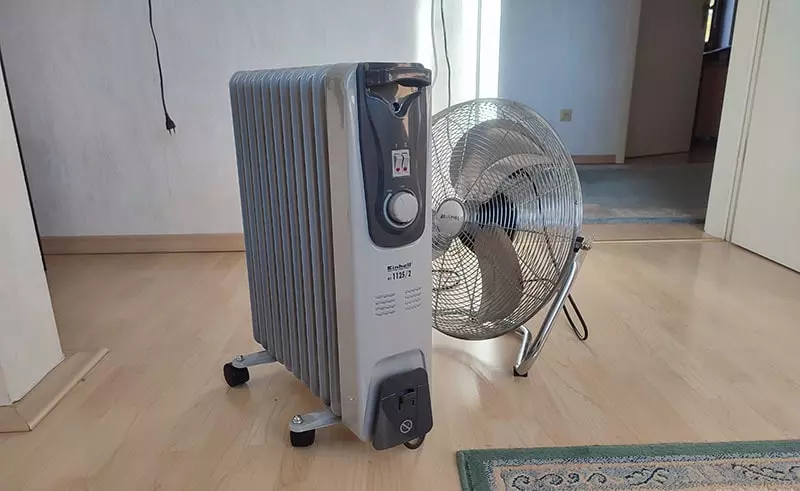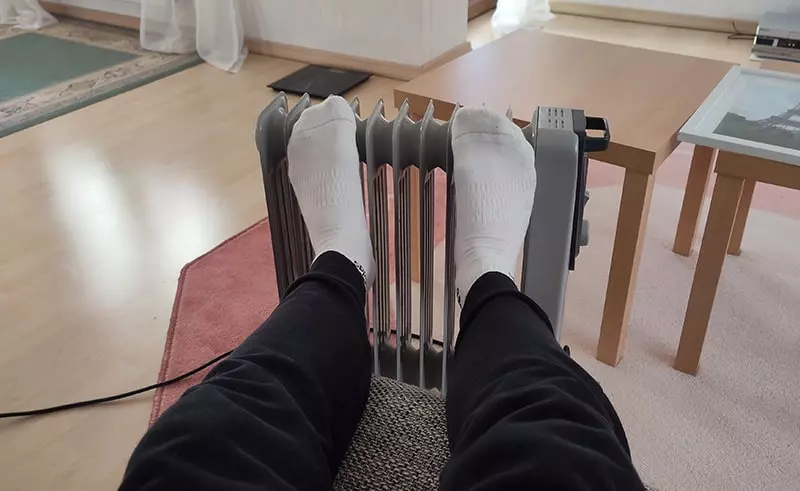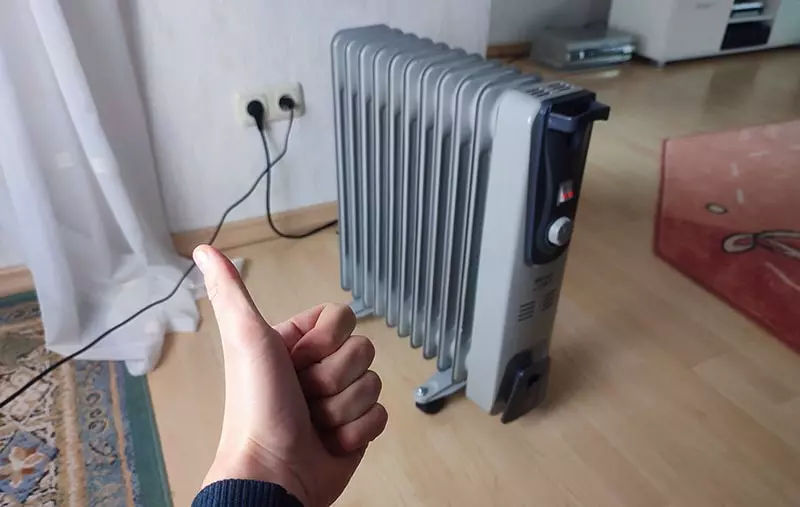How can you improve the heating and cost-efficiency of an oil-filled radiator?
There are three different efficiencies that we want to optimize for:
- Technical efficiency - How much electricity is converted to heat?
- Perceived efficiency - How much heat does actually reach you?
- Cost efficiency - How much heat do you get for your money’s worth?
In this article, we are going to cover all three different kinds of efficiencies. For each efficiency type, I am going to give you straight-to-the-point advice on how to optimize your oil-filled radiator!
Quick answer: Technically, oil-filled radiators are 100% efficient. You can improve its perceived efficiency (the amount of heat reaching you) through proper placement within your room. You can improve the cost-efficiency of your heater by lowering your central heating settings and supplying heat using the oil-filled radiator only in the room you are in.
Let’s have a look at all the steps you can take:
Can you improve the technical efficiency of an oil-filled radiator?
Most electric space heaters (including oil-filled radiators) consume about 1,500W of power.
According to the thermodynamic law of entropy, all energy eventually ends up as heat.
This means that all of the consumed 1,500W of electric power will be converted to heating power.
This means any oil-filled radiator is 100% efficient all of the time. And there is no room for optimization.
At least from a technical perspective.
The reason is that all a physicist looks at is the input power and the output power. And the power you put into a heater is equal to the heating power that comes out of it.
There is no way to improve the technical efficiency of an oil-filled radiator since it is already 100% efficient.
However, as humans, we usually don’t really care for technical efficiency, but rather for how well a heater keeps you warm and how much you pay for it.
That’s why we additionally look at perceived efficiency and cost-effectiveness in the next sections.
How to improve an oil-filled radiator’s perceived efficiency
Perceived efficiency is not something we measure technically. Rather it’s just a look at how warm a heater can make you feel.
The general approach to improving an oil-filled radiator’s perceived efficiency is to find ways to direct the heat toward you.
Since oil-filled radiators distribute the heat evenly in all directions, this is not at all simple.
With other heaters, such as infrared heaters, which radiate heat in one direction only, a simple change in the heater’s placement can have a big positive impact on perceived efficiency.
Anyways, let’s have a look at what you can do:
Use a fan to distribute the heat
Oil-filled radiators distribute the heat evenly across the room. However, it might be (depending on your room’s structure and the heater’s placement) that the heat is trapped in a corner of the room.
Or the heat rises to the ceiling without reaching you.
You can use a fan to blow the heat toward you. This can be any type of fan. But since oil-filled radiators stand on the floor, I’d recommend a floor fan, such as this Lasko fan (click here to view it on amazon).
I am using my own floor fan all the time. The best thing about them is that you can use them in wintertime, to distribute heat in your house, but even more so in summer to cool down your house.
So, a floor fan is a great thing to have for venting and distributing heat.
 Place a floor fan behind your oil-filled radiator to blow the heat into your room
Place a floor fan behind your oil-filled radiator to blow the heat into your room
Touch the oil-filled radiator
Air is an insulator. That’s why you feel warm wearing thick jackets. The thick material traps lots of air. The air pockets prevent the heat from leaving your body.
Because air is an insulator (that prevents the heat from leaving your oil-filled radiator) heating the entire air in your room is generally not very efficient.
But as soon as you touch your oil-filled radiator’s metal body, you notice it’s very hot!
Heat by touch is also called conductive heat.
In general, conductive heat makes you feel very warm. While convection (heat transported by air) heat needs a lot of energy to even reach you.
To make use of conductive heat, you can place your oil-filled radiator in a way that you constantly touch it. Or at least, very close to you.
Of course, this does not work for all settings.
But I’ve found placing my oil-filled radiator under your desk while working very practical. You can put your feet against the heater. And additionally, the desk traps all the heat.
Also, you can place an oil-filled radiator next to your sofa or bed and then throw a large blanket over you and the heater. The blanket traps the entire heat and you will feel a lot warmer.
Don’t worry about the risk of fire. When you are so close to your heater, you can run it on low settings and it still provides more than enough heat.
 I like to put my feet against my oil-filled radiator. Feels extra warm!
I like to put my feet against my oil-filled radiator. Feels extra warm!
Place it in the right spot
Even though the placement of oil-filled radiators does not matter as much as with other heater types (such as infrared or gas heaters), it will still make a difference.
In general, place your oil-filled radiator as close to you as possible.
Then, in addition to the warm air coming from the heater, you will also feel the infrared radiation coming from it.
( Yes, even though oil-filled radiators are not infrared heaters, some of the heat will come off the heater as infrared rays )
Also, when you have a tilted ceiling, you can place your oil-filled radiator below it. The tilt in the ceiling helps distribute the heat more evenly in the room.
Use it in smaller spaces
Oil-filled radiators don’t have that much power. Even though 1,500W are close to the limit of what most US household circuits can supply, it’s still only a third of the heat coming off an average propane heater.
To heat large rooms (over 350 sq. ft) in the cold season you will need either two oil-filled radiators, or another heat source.
Alternatively, use your oil-filled radiator in smaller rooms (300 sq. ft. and smaller). Oil-filled radiators are much more suitable for these small to moderate room sizes.
The reason is that smaller rooms contain less air to heat. This means that they heat up more quickly.
Set higher temperature settings
It might be that your oil-filled radiator does not heat efficiently because of the built-in heating element not receiving enough power.
Also, I find that an oil-filled radiator set to high settings radiates a lot more heat than an oil-filled radiator on lower settings.
Of course, higher settings increase your heater’s electricity consumption.
But in this section, we are only talking about perceived efficiency. And it seems that an oil-filled radiator only really starts radiating heat above a certain setting.
Below that setting, the large metal heating body gets warm or even hot, but the heat does not radiate.
This is obviously not a technical fact. Any heating setting will provide heating power proportional to it.
How to increase an oil-filled radiator’s cost-effectiveness
In this section, we’re going to cover some ways to improve your oil-filled radiator’s cost-effectiveness.
Cost-effectiveness is the amount of heat your get per dollar spent.
Since there are only two variables in this equation (heat & dollars spent), you can only do two things about improving cost-effectiveness:
- Reduce your electricity rate
- Increase the heat you get out of your heater
You can do something about the electricity rates in some places in the world (not everywhere). But you can’t really increase the heat your heater supplies (without increasing electricity consumption).
Let’s have a look at my two suggestions:
Switch electricity providers (if possible in your location)
The Cost-effectiveness of oil-filled radiators is tightly coupled to the electricity rate you are paying.
If your electricity rate decreases, your cost-effectiveness increases.
The easiest way to increase your oil-filled radiator’s cost-effectiveness is to switch electricity service providers to lower your electricity rate.
Now, this would not only improve the cost-effectiveness of your oil-filled radiator, but it would positively affect all the electric devices in your home.
Unfortunately, in the US this works only in the 13 so-called “deregulated states”, where you are free to choose your electricity provider.
Reduce central heating temperature and supply heat using the oil-filled radiator
In my article “Do space heaters save money?” I found out how it’s possible to reduce your utility costs using electric space heaters.
The result is:
You have to reduce your central heating temperature by 8°F and supply heat in the room you are using with your oil-filled radiator.
This will cut your yearly energy expenses by $324.
This is not really a tip to increase the oil-filled radiator’s cost-effectiveness, but instead, you use your oil-filled radiator to increase your entire home’s cost-effectiveness.
What’s a more efficient heater than an oil-filled radiator?
Based on the heating power produced and the running cost, there’s not much you can do to improve your heating efficiency. At least, as long as you stick to electric space heaters.
Electricity is very important since it is such a “high-level” form of energy, which can be used for so many different applications (computing, manufacturing, construction, etc.). Using it for heating is oftentimes a waste.
When you look at the cost-effectiveness of different heaters, you will find that electricity is quite expensive.
In contrast, heat from wood or propane costs less than a third of what you would pay for the same amount of heat using electric heating.
If you have the option I highly recommend switching to a wood-burning stove or gas heating.
It doesn’t matter whether you upgrade your home’s central heating to use wood or gas or you just get a portable propane heater.
Conclusion
Oil-filled radiators are already 100% efficient technically. However, you can increase the perceived efficiency by placing your oil-filled radiator correctly.
Ideally, your oil-filled radiator should stand close to you.
And, if possible you should trap its heat by using it in a small room or by using it below your desk, where you are working, or next to your sofa with a blanket thrown over it.
